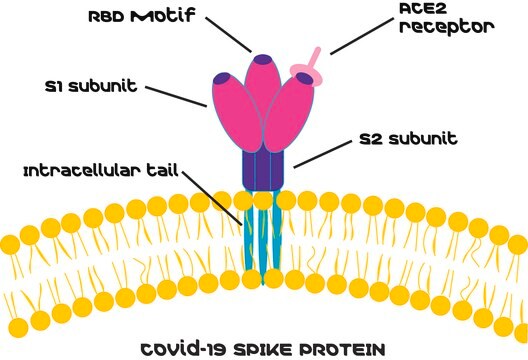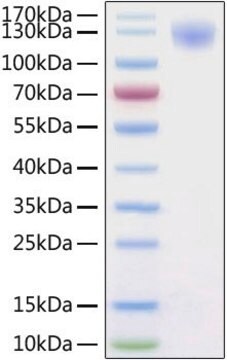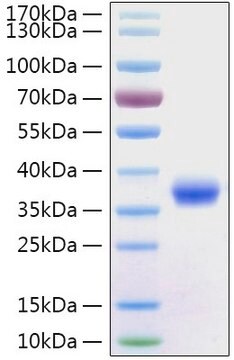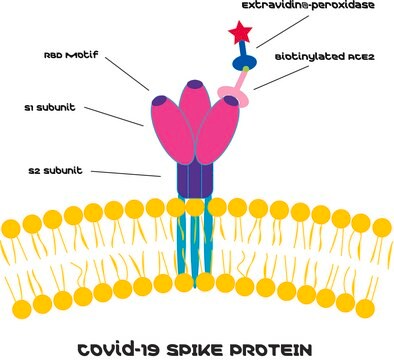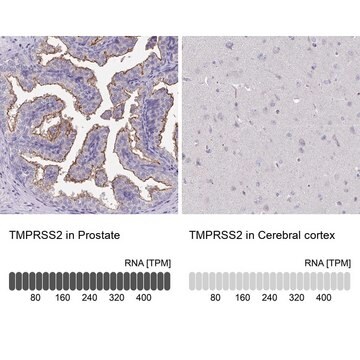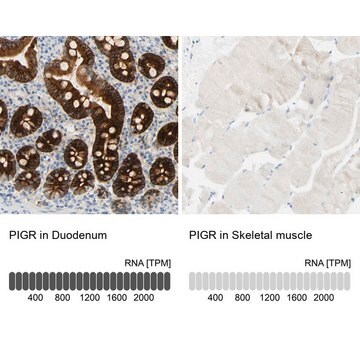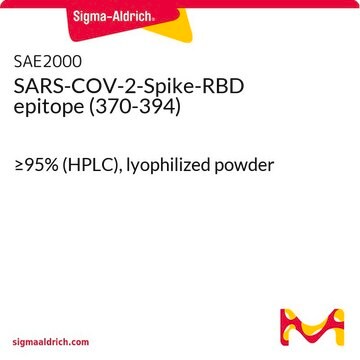SAE0199
SARS-CoV-2 Receptor Binding Domain
Biotin-tagged, Spike protein RBD recombinant,expressed in HEK 293 cells
Synonym(s):
Receptor Binding Domain
Sign Into View Organizational & Contract Pricing
All Photos(1)
About This Item
UNSPSC Code:
12352202
NACRES:
NA.28
Recommended Products
General description
SARS-CoV-2 belongs to Coronaviridae (CoVs) - a large family of viruses that usually cause mild to moderate upper-respiratory tract diseases. CoVs are single-stranded RNA viruses. They have a high mutation rate and are therefore highly diverse. Their hosts include human and non-human mammals, as well as birds. This product is expressed in human HEK 293 cells as a glycoprotein with a calculated molecular mass of 25 kDa (amino acids 319- 541) and includes a C-terminal polyhistidine tag. The DTT-reduced protein migrates as a ~35 kDa polypeptide on SDS-PAGE because of glycosylation. This protein is produced in human cells, without the use of serum. The human cells expression system allows human like glycosylation and folding, and often supports higher specific binding of the protein.
This Spike protein RBD is labeled with biotin, to form biotin-tagged protein. This Spike protein RBD biotin-tagged may serve as a useful tool for binding experiments while detecting protein:protein interaction assays using binding partners such as ACE2. The degree of biotinylation is >=90%. This Spike protein RBD-biotin can be visualized with streptavidin-conjugated probes (e.g., Streptavidin-HRP conjugate).
This Spike protein RBD is labeled with biotin, to form biotin-tagged protein. This Spike protein RBD biotin-tagged may serve as a useful tool for binding experiments while detecting protein:protein interaction assays using binding partners such as ACE2. The degree of biotinylation is >=90%. This Spike protein RBD-biotin can be visualized with streptavidin-conjugated probes (e.g., Streptavidin-HRP conjugate).
Application
The activity of this product is tested by a functional ELISA. Immobilization of ACE2 (Cat. No. SAE0064) at 2 μg/mL (100 μL/well), allows binding of Spike protein RBD, biotin tagged. The half maximal binding (binding which produces 50% of the optimal binding response) is = 2 µg/mL.
Purity: =95% (SDS-PAGE)
Purity: =95% (SDS-PAGE)
- Exploration of the protein protein interaction of CoVs Spike protein with is partners, like ACE2 protein.
- Tool for screening inhibitors for the interaction of CoVs Spike protein with ACE2.
Biochem/physiol Actions
SARS-CoV-2 infects cells which express angiotensin converting enzyme 2 (ACE2). ACE2 binds to the viral envelope-associated spike (S) protein as a cellular receptor, following proteolytic cleavage of both S and ACE2 by serine proteases. S protein is believed to be the target of neutralizing antibodies because it is the main trans-membrane glycoprotein responsible for receptor-binding and virion entry.
The S protein is a trimeric protein. During the binding to ACE2, S protein undergoes a substantial structural rearrangement to facilitate the fusion of the viral membrane with the host cell membrane. The receptor binding domain (RBD) of S protein is the domain that specifically binds to ACE2. RBD is the major target for neutralizing antibodies for coronaviruses, and anti-RBD antibodies likely correlate with virus neutralization.The ACE2:spike interaction has a high affinity of 15 nM.
The S protein is a trimeric protein. During the binding to ACE2, S protein undergoes a substantial structural rearrangement to facilitate the fusion of the viral membrane with the host cell membrane. The receptor binding domain (RBD) of S protein is the domain that specifically binds to ACE2. RBD is the major target for neutralizing antibodies for coronaviruses, and anti-RBD antibodies likely correlate with virus neutralization.The ACE2:spike interaction has a high affinity of 15 nM.
Storage Class Code
11 - Combustible Solids
WGK
WGK 1
Choose from one of the most recent versions:
Certificates of Analysis (COA)
Lot/Batch Number
Sorry, we don't have COAs for this product available online at this time.
If you need assistance, please contact Customer Support.
Already Own This Product?
Find documentation for the products that you have recently purchased in the Document Library.
Our team of scientists has experience in all areas of research including Life Science, Material Science, Chemical Synthesis, Chromatography, Analytical and many others.
Contact Technical Service